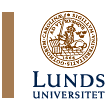

|
Panel No. 15Panel Title: From Landscapes to Genomes: Authoritative Knowledge in Contested DomainsConvenor: Stig Toft Madsen, Associate Professor, International Development Studies, Roskilde University, Denmark Thursday 8 July, 13–18 Panel Abstract: According to one
standard narrative of science, authoritative knowledge of nature
from landscapes to genomes resides in, and is generated by, universities
and similar centres of learning and research, both public and private.
While such institutions may not claim a monopoly on the right to
generate knowledge, they have historically increased their share
of the knowledge generated, patented, applied and administered in
the public sphere. The panel is a “transatlantically modified version” of a roundtable discussion called Knowledge, Nature, Power and States: From Landscapes to Genomes in South Asia held at the 56th Annual Meeting of the Association of Asian Studies, San Diego 4–7 March 2004, and arranged by Ronald Herring and K Sivaramakrishnan (see Panel Number 128 at http://www.aasianst.org/).
Papers accepted for presentation in the panel:Paper Giver 1: Ronald J Herring, Department of Government, Cornell University, USA Paper 1 Title: Continuities Across Domains of Landscapes and Genomes in Public Goods Discourse Paper Abstract: The purpose of this panel is to investigate the intersection of cultural logics and political economy in defining and attaining human collective interests in nature. Any understanding of public goods in nature is impoverished unless it takes into account this intersection of cultural logics and political economy. That is, goods and bads in nature are of necessity embedded in a normative logic that is culturally anchored but demonstrably fluid. Likewise, there are inevitably interests at play, but these are by no means fixed: if nothing else, science continually presents new challenges to the way interests are understood by citizens. For global processes impinging on citizens, consider the sea change introduced by the atmospheric science of ozone holes and global warming. Transgenic organisms represent a particularly interesting illustration of these dynamics. The paper will discuss the politics of transnational science, junk science, and "Western" science: why do some configurations of knowledge claims win politically while others lose? Full paper to be downloaded (as a pdf-file) Paper Giver 2: Bengt G. Karlsson. Department of Cultural Anthropology & Ethnology, Uppsala University, Sweden Paper 2 Title: Knowing Nature from Above: Satellite imagery, land cover change, and community resource management in India Paper Abstract: In this paper I will discuss the political and epistemological consequences of present day usage of remote sensing in assessments of land-cover change; taking the example of forest cover assessments. Satellite imagery has become a major tool for monitoring the environment, and it is quite common that satellite data is quoted as the basis for policy decisions regarding management of natural resources. In the international debate, satellite remote sensing is also presented as a powerful vehicle for achieving sustainable development as well as for effective community resource management. India has a well-developed remote sensing infrastructure and the government is motivating the large investments in satellite technology because of its “developmental applications”. In view of this, it appears critical to interrogate what this turn towards privileging knowledge about nature from above implies in terms of power and control over valuable resources like the forest. It can, for example, be argued that knowledge about nature grounded in people’s lived experience of inhabiting the land might be on the losing end. Paper Giver 3: Peter Andersen, Department of Geography , University of Bergen, Norway Paper 3 Title: Frankenfood or good stuff? Micronutrient rich staple crops for Asia Paper Abstract: New crop varieties are developed
in Asia as new steps are taken in the Green Revolution, and as GM
crops gradually are released in large Asian countries such as China
and India. Although many of these developments are intended to be
pro-poor and environmentally friendly, they are fiercely refused
by environmental organisations. Full paper to be downloaded (as a pdf-file) Paper Giver 4: Stig Toft Madsen, International Development Studies, Roskilde University, Denmark Paper 4 Title: Revolution by Stealth? Paper Abstract: Technologies for the genetic
modification of seeds (such as food grain, cotton, etc) have mostly
been developed in the US. In India, there has been a major debate
about whether or not to allow Genetically Modified Organisms (GMOs)
into Indian agriculture at all. While research has been conducted
on GMOs, commercialization has been delayed or prevented until the
last two years or so. The legalization of GMOs occurred after Bt
Cotton was illegally commercialized. Paper Giver 5: Rajeswari S. Raina, NISTADS, New Delhi Paper 5 Title: Agricultural Biotechnology- Opportunities for learning from the history of agricultural knowledge systems Paper Abstract: This paper argues that the
State-industry-university network in agricultural biotechnology
must learn a few lessons from the history of the agricultural sciences
before it goes further with planning and investing in ag-biotech.
Two of the key institutions (habits of thought/ rules/ norms) that
prevailed over the green revolution economics, politics and science,
are increasingly being questioned. These institutions are (i) the
linear hierarchy of agricultural knowledge generation and utilization;
(ii) the supply side rhetoric of population - maintenance research.
Biotechnology is a useful technical instrument that can and must
be integrated within a framework of ‘problems confronting agriculture
and its knowledge system.’ But can the existing organizations
of agricultural science, gagged by norms of hierarchies, selective
perception, reductionism, and hard science cultures marked by disregard
for the social sciences, driven by a bureaucratic problem solving
zeal that does not provide any scope to understand the ‘problem,’
an incestuous science-State/patronage relationship and an unwillingness
to partner on equal terms with the farming communities, ever understand
its own knowledge system? Paper Giver 6: Krishna Karkee, Lund University International Master’s Programme in Environmental Science (LUMES), Lund University, Sweden Paper 6 Title: Land
Degradation in Nepal: A Menace to Economy and Ecosystems Full paper to be downloaded (as a pdf-file) Paper Giver 7: Sidsel Hansson, Centre for East and Southeast Asian Studies, Lund University, Sweden Paper 7 Title: Re-inventing landscapes and women’s rights in an environmental risk area in northwest India Paper Abstract: In this paper I discuss the ways in which women’s rights and roles are impacted by the ongoing redefinitions of nature in an environmental risk area in northwest India. In this area (Alwar, Rajasthan) the main environmental actors are local NGOs working outside local state structures and with support from donor agencies and neo-Gandhian institutions. It remains crucial for these NGOs that their initiatives and reinventions are seen as legitimate both by local populations and external supporters. Accordingly, the NGOs are involved in a constant negotiation of divergent views on rights and natural resource management. A primary tool for the NGO-led environmental strategy is the reinvention of local, traditional ways of conserving natural resources and shaping landscapes. While the donor agency policies in this specific case are not in conflict with the neo-Gandhian “return to traditional knowledge and usage of landscapes”, their divergent positions become apparent when the question of women’s rights is taken into consideration. This paper mainly focuses on the efforts made by a local NGO to accommodate the divergent discourses on gender, tradition and landscapes. With reference to the Alwar case, my argument is that this process of reconstruction of the local landscapes seems to open up arenas for women’s re-negotiation of their access to resources and civil society agency. Paper Giver 8: Meera Nanda, Hartford, USA Paper 8 Title: Dharmic Ecology and the Neo-Pagan International: The Dangers of Religious Environmentalism in India Paper Abstract: Nearly all major environmentalist
movements in India in recent years – including Chipko, Narmada
Bachao Andolan and to some extent, the movement against genetically
modified crops – have invoked Hindu religious motifs and rituals
in order to mobilize the masses. Environmentalism in India, in other
words, has self-consciously invoked the traditional Hindu conception
of sacredness of nature as a strategic resource for mass mobilization.
Full paper to be downloaded (as a pdf-file) Major Gods and Minor Deities of Science anno 2004:Summing up and Discussion: K. Sivaramakrishnan, Department of Anthropology, University of Washington, USA
SASNET - Swedish South Asian Studies Network/Lund
University
|

